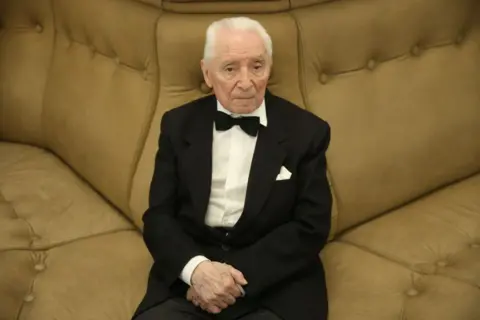Yuri Grigorovich, a towering figure in the world of ballet, has passed away at the age of 98. His enduring legacy as a choreographer has marked him as one of the most significant artists of the 20th century. Grigorovich served as the artistic director of the prestigious Bolshoi Ballet from 1964 until 1995 and was known for his commanding leadership style, referred to by many as ruling with an “iron fist.” Under his direction, the Bolshoi became a central institution in the landscape of Soviet and global ballet.
Grigorovich’s remarkable talent was most vividly showcased through his productions, which included iconic works such as “Ivan the Terrible,” “The Stone Flower,” and “Romeo and Juliet.” His choreography was revolutionary in terms of revitalizing male dance. He demanded exceptional physical strength and artistic expression from male dancers, thus setting new standards in ballet performance. Born in 1927, a decade after the Bolshevik Revolution, Grigorovich’s upbringing was deeply entrenched in the rich traditions of classical ballet, influencing his works that often captured the complexities and emotional depths of narrative ballet.
His connection to ballet was almost familial; his uncle, Georgy Rozai, was a student of the legendary Vaslav Nijinsky. This connection inspired Grigorovich to initially pursue a career as a dancer, eventually performing as a soloist with the Kirov Ballet in Leningrad before making a significant transition to choreography. His diligent and passionate approach to his craft became evident as he began to redefine the narrative potential of ballet on stage.
In 1995, Grigorovich’s tenure at the Bolshoi came to an abrupt end amid disputes regarding performer contracts, leading to a striking moment in the theater’s storied history. This event included a shocked audience when a dancer took to the stage mid-performance to announce that the show was canceled, marking the inaugural dancers’ strike in the Bolshoi’s 200-year legacy. Following his departure, the Bolshoi faced turmoil and fluctuation, leading Grigorovich to establish a new ballet company in Krasnodar, showcasing his resilience and determination.
After the fall of the Soviet Union, the landscape of Russian ballet was fraught with uncertainties. However, Grigorovich’s impact persisted, and he made a notable comeback to the Bolshoi in 2008, contributing as a choreographer and ballet master. His career spanned decades, earning him various accolades and recognitions throughout his life. Among these were the distinguished titles of People’s Artist of the USSR and Hero of Socialist Labour, emphasizing his pivotal role in shaping the ballet scene in the Soviet Union and Russia.
Personal tragedies marked his later life, including the death of his wife, the celebrated ballerina Natalia Bessmertnova, in 2008. His passing coincided with that of Yuri Vladimirov, a noted collaborator and dancer, aged 83, creating a poignant intersection of remembrance for two influential figures in ballet history.
Valery Gergiev, the current head of both the Bolshoi and Mariinsky theatres, reflected on Grigorovich’s legacy in an article for Izvestia, classification him as “a legendary figure who will continue to command respect and admiration for decades to come.” Grigorovich’s contributions have not only transformed ballet but also ensured that the art form remains vibrant and evolving, cementing his place as a titan in the world of dance.
As dancers and choreographers continue to draw inspiration from his innovative works, it is clear that Yuri Grigorovich’s influence will resonate for generations, preserving his legacy within the annals of ballet history.



